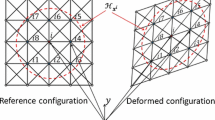Abstract
Tensegrity systems are lightweight structures composed of cables and struts. The nonlinear behavior of tensegrity systems is critical; therefore, the design of these types of structures is relatively complex. In the present study, a practical and efficient approach for geometrical nonlinear analysis of tensegrity systems is proposed. The approach is based on the point iterative method. Static equilibrium equations are given in nodes for subsystems, thus the maximum unknown displacement number in each step is three. Pre-stress forces in the system are taken into account in a tangent stiffness matrix, while similar calculations are carried out for each node in the system which has a minimum of one degree of freedom. In each iteration step, the values found in previous steps are used. When it reaches permissible tolerance of calculation, final displacements and internal forces are obtained. The structural behavior of the tensegrity systems were evaluated by the proposed method. The results show that the method can be used effectively for tensegrity systems.
















Similar content being viewed by others
References
Wang B (1998) Cable–strut systems: Part Ι—tensegrity. J Constr Steel Res 45(3):281–289
Oppenheim IJ, Williams WO (2000) Geometric effects in an elastic tensegrity structure. J Elast 59:51–65
Williamson D, Skelton R, Han J (2003) Equilibrium conditions of a tensegrity structure. Int J Solids Struct 40:6347–6367
Zhang JY, Ohsaki M, Kanno Y (2006) A direct approach to design of geometry and forces of tensegrity systems. Int J Solids Struct 43:2260–2278
Juan SH, Tur JM (2008) Tensegrity frameworks: static analysis review. Mech Mach Theor 43:859–881
Fu F (2004) Structural behavior and design methods of Tensegrity domes. J Constr Steel Res 61:23–35
Motro R, Raducanu V (2003) Tensegrity systems. Int J Space Struct 18:77–84
Pavlovic M (2003) Symbolic computation in structural engineering. Comput Struct 81(22–23):2121–2136
Rhode-Barbarigos L, Jain H, Kripakaran P, Smith IFC (2010) Design of tensegrity structures using parametric analysis and stochastic search. Eng Comput 26(2):193–203
Nuhoglu A (2004) Geometrical static analyses of cable systems. DEU Eng Faculty J 6:4 (in Turkish)
Sultan C, Skelton R (2004) A force and torque tensegrity sensor. Sens Actuators A 112:220–231
Sultan C, Skelton R (2003) Deployment of tensegrity structures. Int J Solids Struct 40:4637–4657
Masic M, Skelton RE, Gil PE (2005) Algebraic tensegrity form-finding. Int J Solids Struct 42:4833–4858
Dub′e_JF, Angellier N, Crosnier B, (2007) Comparison between experimental tests and numerical simulations carried out on a tensegrity minigrid, Eng Struct (available online)
Tibert G, (2002). Deployable tensegrity structures for space applications. PhD dissertation, Royal Institute of Technology, Stockholm
Quirant J, Kazi-Aoual MN, Motro R (2003) Designing tensegrity systems: the case of a double layer grid. Eng Struct 25:1121–1130
Stren IP, (1999). Development of design equations for self-deployable N-strut tensegrity systems. MS thesis, University of Florida
Lazzari M, Vitaliani RV, Majowiecki M, Saetta AM (2003) Dynamic behavior of a tensegrity system subjected to follower wind loading. Comput Struct 81:2199–2217
Jensen Q, Wroldsen AS, Lader PL, Fredheim A, Heide M (2007) Finite element analysis of tensegrity structures in offshore aquaculture installations. Aquac Eng 36:272–284
Adriaenssens SML, Barnes MR (2001) Tensegrity spline beam and grid shell structures. Eng Struct 23:29–36
Author information
Authors and Affiliations
Corresponding author
Rights and permissions
About this article
Cite this article
Nuhoglu, A., Korkmaz, K.A. A practical approach for nonlinear analysis of tensegrity systems. Engineering with Computers 27, 337–345 (2011). https://doi.org/10.1007/s00366-010-0203-9
Received:
Accepted:
Published:
Issue Date:
DOI: https://doi.org/10.1007/s00366-010-0203-9




